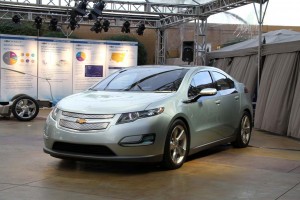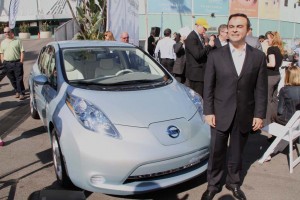
The Chevrolet Volt is moving from prototype to production, but it won't have access to commuter lanes along the way.
Is it a show of favoritism or simply the strict interpretation of the rules? Either way, buyers of the new Chevrolet Volt will not get the coveted sticker that gives them access to the California’s fast-moving commuter lanes, nor will they qualify for a potential $5,000 state-funded rebate.
But those who opt for another new battery car, the 2011 Nissan Leaf, will qualify for both, according to the California Air Resources Board. Considering both vehicles will soon go to market with lease rates of $350 a month, it raises the possibility that CARB will, in effect, be lending support to Nissan at Chevy’s expense.
While a senior General Motors official is clearly disappointed, he stresses that some tweaks to the Volt emission system should allow it to qualify for the HOV – or High-Occupancy Vehicle – lane pass and tax break by 2012, a little more than a year after the first Volt rolls into dealer showrooms. (See Single Occupant Honda CNG and Fuel Cell Vehicles Granted California High Occupancy Vehicle Access)
In the meantime, insists Volt’s program chief Tony Posawatz, “The car won’t have trouble selling,” especially during the first year, he tells TheDetroitBureau.com, when availability of what is technically known as an extended-range electric vehicle, or E-REV, will be limited to just 10,000 vehicles.

The Nissan Leaf -- shown here with CEO Carlos Ghosn -- will have access to the HOV lanes, and get a $5,000 California tax break.
The upcoming launches of Volt and Leaf are significant for a variety of ways. Broadly, the two models will test potential market interest in a new generation of battery-powered vehicles. Unlike earlier hybrids, such as the Toyota Prius and Ford Escape Hybrid, Leaf and Volt are designed to run for extended periods solely on battery power.
But there philosophies differ. Nissan planners are betting that an approximately 100-mile range is more than enough for a portion of the market. GM strategists are convinced that this will generate too much so-called “range anxiety.” Volt was thus designed to provide just enough battery power for the typical daily commute – about 40 miles – but offer a gasoline engine that can kick in for longer drives once the batteries run down.
Initially, CARB officials took steps to promote any truly high-mileage technology, with Prius, in particular, able to garner an HOV lane pass. But the rules recently changed and, at the end of the year, the current stickers will expire. The new focus is on true zero-emission vehicles, like Leaf, though Honda’s FCX fuel cell vehicle and the CNG-powered Civic will also maintain access.
Volt, which can run on gas or electric power, won’t qualify. For now, anyway, explains Posawatz. For roughly the first year the Chevy E-REV is on the market, its emissions system will fall into the ULEV category. But GM engineers are racing to get an updated system in place that will tighten emissions enough to qualify as a P-ZEV, a Partial-Zero-Emissions Vehicle, in bureaucratese.
Will that be enough? “It will,” Posawatz suggests, then adding, “as long as they don’t change the rules again.”
(One possible change actually could work in Volt’s favor. The proposed California law, SB 535, would immediately open up HOV lanes to qualifying plug-in hybrids and E-REVs.)
The GM executive notes that the number of potential HOV stickers will be limited, even for vehicles that qualify, though there’s plenty of evidence that California motorists have so far been motivated as much by commuter lane access as by any financial incentive.
But money could talk a bit louder when the new generation of electric vehicles comes to market. Volt will carry a sticker of $41,000, about $8,000 more than Leaf – though both will be offered for the same $350-a-month lease. However you parse those numbers, there’ll still a sizable premium for battery power for the years to come.
(Click Here for more on Chevrolet Volt pricing.)
But there’s also a growing market for green technology at whatever the cost. Both makers – and many of the other manufacturers planning to follow with electric vehicles of their own – are counting on an initial push from early adopters.
But the goal is to take the technology mainstream as soon as possible. And to boost demand will require not just good products, industry analysts caution, but tax credits and other incentives that will appeal to less green-minded motorists.

To pick a nit, the Volt is not “technically” an Extended Range Electric Vehicle (EREV). It is that because of the GM marketers and spinmeisters. It is technically a series hybrid.
Well, I guess all the lawn mowers, light trucks, 18 wheelers, boats, etc. can breathe a sigh of relief. The air will be cleaner coming out of the exhaust that goes in through the vents on these cars and the HOV lanes will be places to drive for those with bad lungs who need cleaner polluted air. California is my hero!
Actually, Paul, I believe that SB 535 requires AT-PZEV certification for those PHEVs and EREVs to get the HOV Lane sticker. So the 2011 Volt wouldn’t qualify for that, either.
Something I need to follow up on, John. Thanks for the tip. But the key is making it possible for some other technologies to qualify.
Paul A. Eisenstein
Publisher, TheDetroitBureau.com
@JSwenk: Volt becomes a series hybrid only after the grid-charged battery has been depleted.
As for me, I believe in supporting my own country first so HOV lane or no HOV lane it will be the Volt for me.
Has GM decided on what gas mileage they’re going to put on the Volt? I know this was an issue before.
GM initially used an absurd and very tentative 230 mpg rating that relied on a proposed EPA measurement system. The backlash seems to have gotten everyone to think twice about that strategy. Expect to see more real-world figures closer to launch, but probably something in the 40+ mpg range on gasoline power.
Paul A. Eisenstein
Publisher, TheDetroitBureau.com